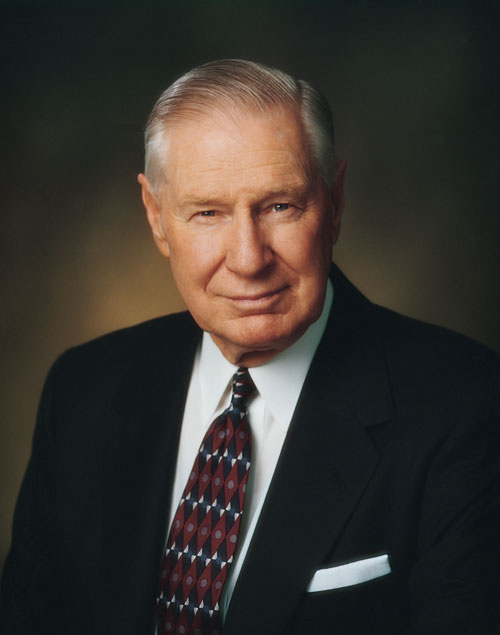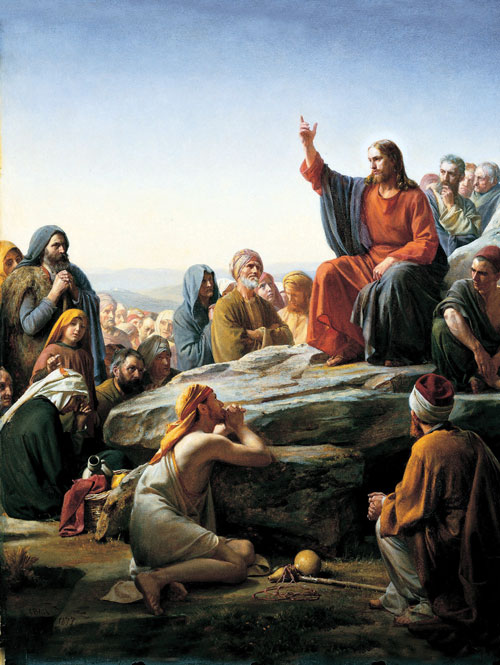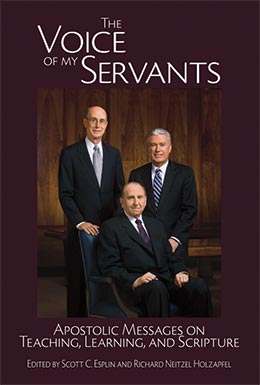"A Surety of a Better Testament"
James E. Faust
James E. Faust, “‘A Surety of a Better Testament,’” in The Voice of My Servants: Apostolic Messages on Teaching, Learning, and Scripture, ed. Scott C. Esplin and Richard Neitzel Holzapfel (Provo, UT: Religious Studies Center, Brigham Young University; Salt Lake City: Deseret Book, 2010), 211–20.
President James E. Faust (1920-2007) was a member of the First Presidency when this article was published. Address at the Sidney B. Sperry Symposium at Brigham Young University on October 20, 1009, published in Sperry Symposium Classics: The New Testament (Provo, UT: Religious Studies Center, Brigham Young University, 2006), 1-7.

My calling places upon me a responsibility to witness concerning the reality of the Savior and His mission. I hope that my assignment with the BYU Jerusalem Center and the Holy Land will be a helpful background against which to discuss some phase of the life and ministry of the Lord Jesus Christ.
I take my text from the Apostle Paul’s Epistle to the Hebrews: “By so much was Jesus made a surety of a better testament” (Hebrews 7:22). What is a “surety”? We find in turning to the dictionary that surety is “the state of being sure;” it is an undertaking or a pledge. It also refers to “one who has become legally liable for the debt, default, or failure in duty of another.”[1] Do not the Savior and His mission have claim upon all these meanings?
What is a testament? The primary meaning of “testament” is a “covenant with God.” It is also holy scripture, a will, a witness, a tangible proof, an expression of conviction.[2] So the Savior as a surety is a guarantor of a better covenant with God.
We all know that moving from the Old Testament to the New Testament is moving from the rigid formality of the letter of the law to the spirit of the law. It is a better testament because the intent of a person alone becomes part of the rightness or wrongness of human action. So our intent to do evil or our desire to do good will be a free-standing element of consideration of our actions. We are told we will be judged in part by the intent of our hearts (see D&C 88:109). An example of being convicted by free-standing intent is found in Matthew: “Ye have heard that it was said by them of old time, Thou shalt not commit adultery: But I say unto you, That whosoever looketh on a woman to lust after her hath committed adultery with her already in his heart” (Matthew 5:27–28).
 Carl Heinrich Bloch, Sermon on the Mount.
Carl Heinrich Bloch, Sermon on the Mount.
This New Testament is harder doctrine. In the old English common law, a formality and rigidity developed in the administration of the law to the point where, for justice to be obtained, the law of equity developed. One of my favorite maxims about equity is, “Equity does what ought to be done.” The New Testament goes further. In a large measure we will be judged not only by what we have done but by what we should have done in a given situation.
Much of the spirit of the New Testament is found in the Sermon on the Mount. The New Testament requires a reconciliation of differences. “Therefore if thou bring thy gift to the altar, and there rememberest that thy brother hath ought against thee; leave there thy gift before the altar, and go thy way; first be reconciled to thy brother, and then come and offer thy gift” (Matthew 5:23–24).
In the New Testament, swearing becomes completely prohibited:
Again, ye have heard that it hath been said by them of old time, Thou shalt not forswear thyself, but shalt perform unto the Lord thine oaths: But I say unto you, Swear not at all; neither by heaven; for it is God’s throne: Nor by the earth; for it is his footstool: neither by Jerusalem; for it is the city of the great King. Neither shalt thou swear by thy head, because thou canst not make one hair white or black. But let your communication be, Yea, yea; Nay, nay: for whatsoever is more than these cometh of evil (Matthew 5:33–37).
Then follows more of the difficult doctrine of the New Testament:
But I say unto you, That ye resist not evil: but whosoever shall smite thee on thy right cheek, turn to him the other also.
And if any man will sue thee at the law, and take away thy coat, let him have thy cloke also.
And whosoever shall compel thee to go a mile, go with him twain.
Give to him that asketh thee, and from him that would borrow of thee turn not thou away.
Ye have heard that it hath been said, Thou shalt love thy neighbour, and hate thine enemy.
But I say unto you, Love your enemies, bless them that curse you, do good to them that hate you, and pray for them which despitefully use you, and persecute you. (Matthew 5:39–44)
The New Testament suggests a new form and content of prayer. It is profoundly simple and uncomplicated:
And when thou prayest, thou shalt not be as the hypocrites are: for they love to pray standing in the synagogues and in the corners of the streets, that they may be seen of men. Verily I say unto you, They have their reward.
But thou, when thou prayest, enter into thy closet, and when thou hast shut the door, pray to thy Father which is in secret; and thy Father which seeth in secret shall reward thee openly.
But when ye pray, use not vain repetitions, as the heathen do: for they think that they shall be heard for their much speaking.
Be not ye therefore like unto them: for your Father knoweth what things ye have need of, before ye ask him.
After this manner therefore pray ye: Our Father which art in heaven, Hallowed be thy name.
Thy kingdom come. Thy will be done in earth, as it is in heaven.
Give us this day our daily bread.
And forgive us our debts, as we forgive our debtors.
And lead us not into temptation, but deliver us from evil: For thine is the kingdom, and the power, and the glory, for ever. Amen. (Matthew 6:5–13)
The New Testament suggests that the doing of our good works ought to be in secret: “But when thou doest alms, let not thy left hand know what thy right hand doeth: That thine alms may be in secret: and thy Father which seeth in secret himself shall reward thee openly” (Matthew 6:3–4).
But the greatest challenge, the hardest doctrine, is also found in the Sermon on the Mount: “Be ye therefore perfect, even as your Father which is in heaven is perfect” (Matthew 5:48).
The Savior as “the mediator of the new testament” (Hebrews 9:15) introduced a higher law of marriage:
And the Pharisees came to him, and asked him, Is it lawful for a man to put away his wife? tempting him.
And he answered and said unto them, What did Moses command you?
And they said, Moses suffered to write a bill of divorcement, and to put her away.
And Jesus answered and said unto them, For the hardness of your heart he wrote you this precept.
But from the beginning of the creation God made them male and female.
For this cause shall a man leave his father and mother, and cleave to his wife;
And they twain shall be one flesh: so then they are no more twain, but one flesh.
What therefore God hath joined together, let not man put asunder. (Mark 10:2–9)
The challenge of Jesus was to replace the rigid technical “thou shalt not” of the law of Moses that the spiritually immature children of Israel needed with the spirit of the “better testament.” How was that to be done? Time was short. He had only three years. How should He begin? Obviously He must begin with the Apostles and the small group of disciples around Him who would have the responsibility to carry on the work after His death. President J. Reuben Clark Jr., a counselor in the First Presidency, describes this challenge as follows: “This task involved the overturning, the virtual outlawing, of the centuries-old Mosaic law of the Jews, and the substitution therefore of the Gospel of Christ.”[3]
It was not easy for even the Apostles to understand, of whom doubting Thomas is a good example. Thomas had been with the Savior when the Savior, on several occasions, foretold of His death and Resurrection. Yet when Thomas was told that the resurrected Christ lived, he said, “Except I shall see in his hands the print of the nails, and put my finger into the print of the nails, and thrust my hand into his side, I will not believe” (John 20:25). Perhaps Thomas can be forgiven because so great an event had never happened before.
What about Peter’s conversion to the great principle that the gospel of Jesus Christ is for everyone? He had been an eyewitness, as he stated, that “we have not followed cunningly devised fables, when we make known unto you the power and coming of our Lord Jesus Christ, but were eyewitnesses of his majesty” (2 Peter 1:16). To what had Peter been an eyewitness? He had been an eyewitness to everything in the Savior’s ministry. He had seen the Savior welcome the Samaritans, who were loathed by the Jews, following the encounter with the Samaritan at the well of Jacob (see John 4). Peter had seen a vision and heard the voice of the Lord, saying, “What God hath cleansed, that call not thou common” (Acts 10:15). Finally, fully converted and receiving a spiritual confirmation, Peter opened his mouth and said, “Of a truth I perceive that God is no respecter of persons: but in every nation he that feareth him, and worketh righteousness, is accepted with him” (Acts 10:34–35).
It is strengthening to review the testimonies of the Apostles that Jesus is, in fact, the Christ. These testimonies are also a surety of a better testament. The first recorded testimony of the divinity of the Savior is the occasion of Jesus walking on the water, which is most fully recorded in Matthew 14:24–33:
But the ship was now in the midst of the sea, tossed with waves: for the wind was contrary.
And in the fourth watch of the night Jesus went unto them, walking on the sea.
And when the disciples saw him walking on the sea, they were troubled, saying, It is a spirit; and they cried out for fear.
But straightway Jesus spake unto them, saying, Be of good cheer; it is I; be not afraid.
And Peter answered him and said, Lord, if it be thou, bid me come unto thee on the water.
And he said, Come. And when Peter was come down out of the ship, he walked on the water, to go to Jesus.
But when he saw the wind boisterous, he was afraid; and beginning to sink, he cried, saying, Lord, save me.
And immediately Jesus stretched forth his hand, and caught him, and said unto him, O thou of little faith, wherefore didst thou doubt?
And when they were come into the ship, the wind ceased.
Then they that were in the ship came and worshipped him, saying, Of a truth thou art the Son of God.
The second is that of Peter. The fullest account appears in Matthew, with which we are all familiar:
When Jesus came into the coasts of Cæsarea Philippi, he asked his disciples, saying, Whom do men say that I the Son of man am?
And they said, Some say that thou art John the Baptist: some, Elias; and others, Jeremias, or one of the prophets.
He saith unto them, But whom say ye that I am?
And Simon Peter answered and said, Thou art the Christ, the Son of the living God.
And Jesus answered and said unto him, Blessed art thou, Simon Bar-jona: for flesh and blood hath not revealed it unto thee, but my Father which is in heaven.
And I say also unto thee, That thou art Peter, and upon this rock I will build my church; and the gates of hell shall not prevail against it. (Matthew 16:13–18)
The third instance again involves Peter. After the great sermon on the bread of life, in which the Savior made clear to those who had been fed by the loaves and the fishes that He and His doctrine were the Bread of Life, John records: “From that time many of his disciples went back, and walked no more with him. Then said Jesus unto the twelve, Will ye also go away? Then Simon Peter answered him, Lord, to whom shall we go? thou hast the words of eternal life. And we believe and are sure that thou art that Christ, the Son of the living God” (John 6:66–69).
The testimony of the divinity of the Savior given by God the Father and heard by Peter, James, and John is recorded in connection with the happenings on the Mount of the Transfiguration. The accounts of Matthew, Mark, and Luke all tell of the appearance of Moses and Elias talking to the Savior. Matthew records:
Then answered Peter, and said unto Jesus, Lord, it is good for us to be here: if thou wilt, let us make here three tabernacles; one for thee, and one for Moses, and one for Elias.
While he yet spake, behold, a bright cloud overshadowed them: and behold a voice out of the cloud, which said, This is my beloved Son, in whom I am well pleased; hear ye him.
And when the disciples heard it, they fell on their face, and were sore afraid.
And Jesus came and touched them, and said, Arise, and be not afraid.
And when they had lifted up their eyes, they saw no man, save Jesus only.
And as they came down from the mountain, Jesus charged them, saying, Tell the vision to no man, until the Son of man be risen again from the dead.
And his disciples asked him, saying, Why then say the scribes that Elias must first come?
And Jesus answered and said unto them, Elias truly shall first come, and restore all things.
But I say unto you, That Elias is come already, and they knew him not, but have done unto him whatsoever they listed. Likewise shall also the Son of man suffer of them.
Then the disciples understood that he spake unto them of John the Baptist. (Matthew 17:4–13)
We are grateful for these profound statements of the “eyewitnesses of his majesty” (2 Peter 1:16). They form part of the footings of our faith. But the miracles performed by the Savior and the testimonies of those who saw and heard were far from convincing to everyone, perhaps because a testimony is such a personal, spiritual conviction.
The New Testament is a surety of better testament because so much is left to the intent of the heart and of the mind. The refinement of the soul is part of the reinforcing steel of a personal testimony. If there is no witness in the heart and in the mind, there can be no testimony. The Sermon on the Mount produces deep, spiritual reinforcing that moves us to higher spiritual attainment.
I leave with you my blessing. May the Lord watch over you and strengthen you. I invoke a blessing upon the institutions sponsoring the Sperry Symposium to be powerful in instructing faith and witness and testimony. And I witness to you in the authority of the holy apostleship of the divinity of the calling and mission of the Savior and of the Restoration of the gospel by Joseph Smith. To this I bear witness and testimony in the name of the Lord Jesus Christ, amen.
© Intellectual Reserve, Inc.
Notes
[1] Merriam-Webster’s New Collegiate Dictionary, 11th ed., s.v. “surety.”
[2] Merriam-Webster’s New Collegiate Dictionary, s.v. “testament.”
[3] J. Reuben Clark Jr., Why the King James Version (Salt Lake City: Deseret Book, 1979), 51.
